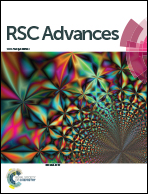BiOBr nanoplate-wrapped ZnO nanorod arrays for high performance photoelectrocatalytic application†
Abstract
BiOBr nanoplates (NPs) decorated vertically aligned ZnO nanorod arrays (NRAs) have been successfully synthesized by a facile and cost-effective solvothermal process. The obtained ZnO/BiOBr heterostructured photoanode shows an enhanced water splitting performance compared to pure ZnO and BiOBr photoanodes, which may be mainly attributed to the formation of a heterojunction that facilitates the separation and transfer efficiency of photoinduced charges to generate a higher current. Moreover, Rhodamine B (RhB) was chosen as a model pollutant to evaluate the photoelectrocatalytic activity of the electrodes. As expected, the ZnO/BiOBr photoanode exhibits a much higher degradation ability than pure ZnO and BiOBr photoanodes, and achieves the highest photoelectrocatalytic degradation efficiency (95.4%) after irradiation for 100 min. Additionally, main reactive species trapping trials demonstrate that ˙OH and/or ˙O2− radicals play significant roles in the photocatalytic degradation process. The above results indicate that the novel photoanode may serve as a promising catalyst toward the practical application of photoelectrochemical water splitting and organic pollutant degradation.


 Please wait while we load your content...
Please wait while we load your content...